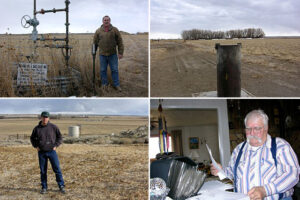Andrea Peacock
- 2010

Fellowship Title:
- Searching for Oil and Gas Beneath America’s Sacred Lands
Fellowship Year:
- 2010

Is Wyoming Ruining Water Supplies to Produce Natural Gas?
PAVILLION, WY—Jeff and Rhonda Locker’s water changed abruptly one day in the mid-1990s while Rhonda was doing the laundry. A Denver-based gas company was working over an old well in back of their house. Suddenly, the wash water turned black. “It happened just like that,” Jeff Locker says. “I stopped him and asked him what he did to our water, and of course he didn’t do anything to our water… It’s been bad ever since.” Donna Meeks’ well water was so good, she used to haul it to town for the school office coffee pot. Neither she nor her husband Louis, noticed anything wrong until her co-workers stopped drinking the coffee. It was 2004, and a Canadian company, EnCana, had just drilled a new well about 500 feet from the Meeks home. Some visiting friends later said they noticed the water tasted and smelled like gas, but didn’t want to be rude by saying anything about it. John and Cathy Fenton had no reason to suspect there was anything wrong with their water—it tasted fine.
The Environmental Toll of Gas Development
BLANCO, New Mexico—Chris Velasquez sees the impacts of gas development in the San Juan Basin of northern New Mexico through the eyes of a rancher. He and his dad ran cattle, until recently, on a grazing allotment called the Rosa, rolling high desert lands punctuated by bluffs and arroyos, ringed by mesas, adjacent to the Carson National Forest on the east, the Southern Ute reservation to the north, and bordered on the west by Navajo Lake. In a way, it’s what’s left of Velasquez’ ancestral homeland—his roots in this country pre-date the arrival of both drillings rigs and Anglos. “We used to live where the Pine River and the San Juan meet up here, then when they built the lake, it either was drown or move,” he says. In 1962, the Bureau of Reclamation completed a dam stretching three-quarters of a mile across the San Juan River. The idea was to control flooding and provide irrigation water for the Navajo tribe. It also displaced Velasquez’ community. “All my ancestor’s on my mom’s side, well on
Energy Pollution, Past and Future, in Utah’s Indian Country
ANETH, Utah—I first climbed the sacred butte at the edge of the Greater Aneth oil field in 1998. My husband, Doug, had been here before and knew where to find hand and footholds in a break along the steep sides. He told me there were remains of about a dozen kivas on top, underground ceremonial structures built by Pueblo people. Usually entered through a hole in the roof, the interior accessed by ladder, these kivas had deteriorated over the centuries. All that was left, he said, were the hot tub-sized pits. We clambered up and were greeted by a sight he had not expected. The kivas were marked with stakes and flagging, a sign that contract archeologists had been through here, cataloging the site in advance of oil and gas rigs. As the sun set, we removed everything we could, hauling the trash with us. Returning several times during the next ten years, we found it remained untouched, as though no one had been here since the original architects. Nowhere else in the United States
The Treasure of the Rocky Mountain Front
BROWNING, MT—Nowhere in the West does the rolling sea of the high plains meet the mountains with such dramatic effect as in northwestern Montana. State Highway 2 stretches through the northern Hi-Line for miles of coulees and intermittent creeks, antelope, buffalo and Plains Indian country, crossing the seemingly endless, expansive prairie that gives the Big Sky Country its name, before crashing abruptly into the Rocky Mountain Front. A patchwork of national park and national forests, reservation and rangeland, the sparsely populated Front provides one of the last best refuges in the lower 48 states for grizzly bears, and shelters the nation’s largest bighorn sheep herd. A great span of wilderness totaling five million acres that extends from the state’s capital in Helena to the Canadian border, the Front hosts every single species of animal that lived here when Meriwether Lewis and William Clark arrived 200 years ago, with the exception of free-ranging bison. Oil and gas companies have coveted the Rocky Mountain Front—known to geologists as the Montana Thrust Belt—for decades. The kind of violent
